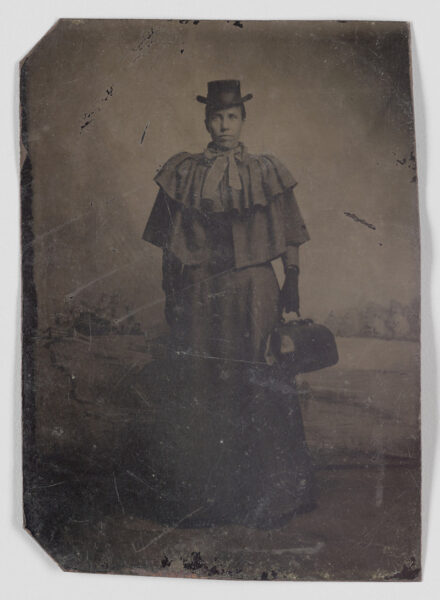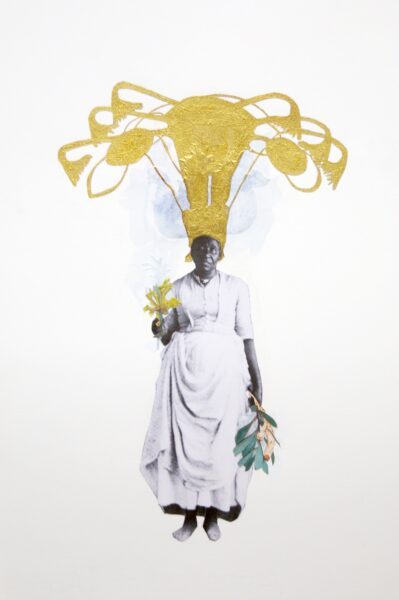By Dr. Edna Bonhomme
Historian of science, writer, and interdisciplinary artist
Art Hx 2021-2022 Interpretive Fellow
Medical knowledge is frequently shifting, with its evolution often depicted through text, as well as image. In the early modern period, there were two simple ways to be instructed about the body; one was through experimentation, and another was through a textbook. The first printed medical textbook, Francisco Bravo’s Opera Medicinalia, was published in 1570 in Mexico City.[1] Hand-printed medical treatises had been a common practice for Arab, Chinese, and Greek physicians, who provided a list of therapeutic herbal reagents or the steps for bloodletting. The medical textbook, physicians, illustrators, and patients were part of that story. By the nineteenth century, medical instruction took on a different form when compared to the apprentice model of the medieval period, and detailed illustrations provided ample instruction about the human body as well as a visual landscape for how to conduct surgeries. One of the many textbooks that fulfilled this gap was Henry Savage’s monograph, The surgery, surgical pathology and surgical anatomy of the female pelvic organs. The text was used to instruct young medical students about the uterus, clitoris, and other reproductive organs.[2] Trained as a physician at the Westminster Hospital School of Medicine in London, Henry Savage (1810-1900) eventually became a lecturer on anatomy. Later, he was appointed physician at the Samaritan Free Hospital for Women and Children, of which he was one of the founders. By his death, his book had gone through three editions. In the introduction to the third edition, published in 1876, he noted that the anatomical images included in the book were selected from numerous sources and stated he chose images that were pathological in content.[3] Overall, the medical illustrations were “intended to illustrate the uterine displacements which can possibly happen.”[4]

J.B. Léveillé, Dr. James Marion Sims and Nurse Repairing a Vesico-vaginal Fistula Patient, 1870. In Henry Savage, The Surgery, Surgical Pathology, and Surgical Anatomy of the Female Pelvic Organs, in a Series of Coloured Plates Taken from Nature with Commentaries, Notes, and Cases, 2nd. ed. (London: J. & A. Churchill, 1870). Image Courtesy of the Hagströmer Medico-Historical Library, Karolinska Institutet
On the surface, Savage’s book appears as a standard nineteenth medical text, with its anatomical drawings flattening the abstraction of the human subject. However, Jean Baptiste Léveillé, an artist known for producing anatomical lithographs at the time, has illustrations in Savage’s book which capture the human body and its subsidiaries in many ways. The diagrammatic figures have topographical variations which focus on different body parts, in a way making flesh come to life. “Dr. James Marion Sims and nurse repairing a vesicovaginal fistula patient,” is an image of the late physician James Marion Sims, an unnamed nurse, and an unnamed patient. The physician is seated, with his back turned to the observer, while the nurse is glancing down, diligently assisting him. At the center of the image, a patient’s legs and rear-end are exposed; they wear white stockings, black shoes, and a dark blue garment. Surrounding the main image are several micro diagrams showing medical equipment and a visual organ. But what we see is how medicine’s pedagogy is contrasted with the rawness of the comatose body—the neutral colors painted on a cream-colored paper, the sequins and fringes, the anatomical parts home in on the vagina, a surgical procedure embroidered in stitching a wound. On display is a procedure for vesicovaginal fistula, a non-fatal reproductive ailment that can potentially complicate childbirth. Like fibroids today, there was no effective treatment or care. Missing from these figures are any mention of anesthesia and the name of the women who are portrayed.
Tainted Medicine: The Problem with J. Marion Sims
The image is didactic, primarily revealing the steps for repair. Seen through this lens, it’s hard to look at Léveillé’s lithograph without thinking about the murkiness of James Marion Sims’s legacy, the named subject of the diagram. Born in South Carolina, Sims (1813–1883) was a white southern man who benefitted from a class-based racial order. Sims, often called the “father of gynecology,” began as an ambitious plantation physician, the inventor of an inverted speculum and modified catheter.[5] In 1853, he moved to New York City, and two years later, he founded the Woman’s Hospital, and later he performed medical procedures on indigent women. Before he carried out these procedures on an ethnically diverse set of working poor women in New York, he experimented on the enslaved in the south. In recent years, his experiments and his role as an enslaver have been called into question, mostly because of the agency he exercised over his Black patients and the powerlessness many of them had as research subjects. Writing for the New York Medical Gazette and Journal of Health in 1854, James Marion Sims commented, “For this purpose [surgical experiments] I was fortunate in having three young healthy colored girls given to me by their owners in Alabama, I agreeing to perform no operation without the full consent of the patients.”[6] But then he continued that “the owners agree[d] to let me keep them (at my own expense) till I was thoroughly convinced whether the affection could be cured or not,” which suggests that the enslaved women did not have sole proprietorship over their bodies.[7] His experiments garnered him status as a demi-god within his profession and as a libertine by some Black women he experimented on. However, it is not just a matter of whether he exercised experimental and surgical techniques, but where and how he was able to do so. Sims and his defenders often justified these procedures by claiming that the surgeries far outweighed the horrific conditions of Black women’s lives. Yet, they never asked who made the lives of enslaved Black women so difficult in the first place.
Attending to Sim’s legacy is not only a matter of assessing contributions to the field of gynecological medicine, nor is it just a matter of taking him for his word; rather, it is important to see how his experiments were structured on Black women’s bodies and how this clarifies Black women’s reproductive lives as agents in the material and discursive economies of racial capitalism. As scholar and performer Terri Kapsalis notes, Sims took advantage of the situation by experimenting mostly on enslaved Black women who had little to no autonomy in a society that deemed most Black people as property.[8] During his lifetime, Sims set up a hospital, which initially had eight beds, for the enslaved and manumitted.[9] By design, the facility mainly served Black people, and it was here that Sims could carry out his procedures.
But Sims was not unique, nor was he the only nineteenth-century physician that had ethically dubious experiments. Medical doctors experimented on Black women’s bodies in intense and complicated ways. In 1835, four doctors conducted surgery on a thirty-five-year-old enslaved Black woman, removing her uterus. Such experiments also enacted science outside the realm of normalcy. Historian Deirdre Cooper Owens writes, “Sims has been painted as either a monstrous butcher or a benign figure who, despite his slave owning status, wanted to cure all women from their distinctly gendered suffering.”[10] Owen opposes reductionism and says that his behavior was common for the time. But it begs the question: Was Sims a monster or a product of his time? Some would argue that he was a brute. In Black on Both Sides, scholar C. Riley Snorton outlines Sim’s research and evinced that not only were his procedures opaque in their effectiveness but that in one surgery, his formerly enslaved patient Lucy nearly died after he failed to remove a sponge from her urethra.[11] What Snorton shows is that these medical experiments were not only exploitative in composition, but incompetent in their execution. The concerns raised by contemporary Black scholars like Cooper Owens and Snorton are relevant and pressing with regards to medicine’s dual ability to cause relief and pain. For scholars that attend to the misgivings of the oppressed, and most notably the wayward lives of Black women, what is surprising is how enslaved Black people were subjected to pain even though they could have been given anesthesia, as the reagent was available during Sims’s time.
This begs another question: What were the parameters of enslavement? Scholar Christina Sharpe offers insight. “The black and blackened bodies become the bearers (through violence, regulation, transmission, etc.) of the knowledge of certain subjection as well as the placeholders of freedom for those who would claim freedom as their rightful yield.”[12] Echoing Sharpe’s observation about the experience of enslaved Black people, enslavement was a difficult, exhausting affair where their bodies were moved from the plantation to legal apartheid. Yet, beyond this gruesome reality, there were other possibilities for how Black women, and by extension Black women healers, moved through space. Black women doctors feature in the literary and historical landscape of the nineteenth-century US in Kaitlyn Greenidge’s 2021 historical fiction book Libertie, which provides a penetrating tale of the daughter of one of the first Black women doctors in the United States.[13] Although Greenridge’s text is a work of fiction, the events evoke real-life African American women who exercised their newfound freedom during the reconstruction era by practicing medicine through tender and spectacular modes of healing, such as when the protagonist proclaims, “I saw my mother raise a man from the dead.”[14]

Tintype of a woman carrying a medical bag, 1890s. Collection of the Smithsonian National Museum of African American History and Culture. Public Domain
Visualizing Black Women Healers
In Tintype of a woman carrying a medical bag (1890), an anonymous Black woman holds a medical bag, likely full of healing supplies but also possibly packed with one of her pristine dresses. She looks straight at the camera, and in a way through us. Her bag is solely hers to carry, and in this vein, we are reminded of the potential ease and grace Black healers offered to their kinfolk. We do not see a natural landscape or office; she exists in a mostly white space with a cloth backdrop with something, perhaps faint trees, on a low horizon line. She is untethered and appears to be marching with an expression that contains the look of freedom. Perhaps this is a portrait she would have stood for in a photographer’s studio. She likely sought this out—maybe recording herself as she wanted to be seen.
This tintype is not an exception, nor was healing solely relegated to the formerly enslaved. In a sweeping account of medicinal healing in the eighteenth-century Americas, historian Londa Schiebinger examines in Secret Cures of Slaves how the enslaved found substance and space to heal even when they were living on a torturous plantation.[15] Not only did enslaved Africans improve the survival of crops in the Caribbean, but they also provided herbal remedies to the colonies. History, and literature inspired by it, shows that Black women healed themselves and others, even when medical discrimination was rife.

Andrea Chung, Crowning I, 2014. Image courtesy of the artist
The expansive and rich accounts of Black women healers reveal themselves throughout various visual aesthetics, with Black women’s autonomy central to the radical praxis of maternal health. Take artist Andrea Chung’s Crowning I (2014), which is part of her wider practice that features unambiguously Black women on display. Constructed with collage, ink, and color pencil, the image appears initially raw, while also showing the women as regal people. On Chung’s subject’s head rests a golden uterus. With austere features, the woman stands barefoot, carrying colorful plants in both hands. Crowning I is part of a broader series of works using historical photographs to explore everyday Black women’s lives. Chung’s work is inspired by Black midwives in the Caribbean and the US South, showing how birthing practices are passed on from one generation of women to another; her work visualizes that this reproductive knowledge is not just found in the realm of the book but is embodied and intergenerational. The image is enchanting, not merely due to the gold, but because it fashions these women as queens. Chung’s piece might seem fantastical, or even have a candid style, but what it shows is that Black women’s bodies are marked by a luminous fluidity. Chung’s series shows an affably intimate set of Black bodies.
While distinct in their construction, artist, and purpose, Tintype of a woman carrying a medical bag and Andrea Chung’s Crowning I unearth how anatomical visual culture can be read as syncretic, that is fusing history with the present, integrating science with art. Both pieces situate Black women as medical stewards, infusing and molding knowledge. They put on display an epistemology invested in the labor of Black healers noticing, touching, and living within a history that was not built for their survival.
The more conscious society becomes of Black women’s humanity, the more we take stock of the violence of medical history and think about the representation of Black women’s bodies in medicine. In historian Rana Hogarth’s monograph Medicalizing Blackness, she tells the story of how science was not only racialized, but how doctors were active in creating and maintaining a fabricated racial hierarchy.[16] The growing work by Black feminist historians has proven that memory can be revised. For over a century after his death, James Marion Sims was celebrated and cited, yet his actions are no longer seen as acceptable medical experiments.[17] By the end of the twentieth century, Sims’s accolades were not enough when confronted with present-day ethical parameters that no longer excused his reprehensible actions. In writer J. C. Hallman’s “Monumental Error,” the author recounts how the statue of Sims in New York’s Central Park was being called into question at a seminal moment in 2017 when Confederate monuments were being taken down throughout the US.[18] By 2018, the statue of Sims was removed, marking the first time a statue was permanently demounted in New York City. As medicine—the procedures, experiments, and medical journals— transforms, so will the people that the profession reveres.
[1] Michael J. North, “The First Medical Book Printed in the New World,” National Library of Medicine, October 29, 2014, https://circulatingnow.nlm.nih.gov/2014/10/29/the-first-medical-book-printed-in-the-new-world/.
[2] Henry Savage, The surgery, surgical pathology and surgical anatomy of the female pelvic organs: in a series of colored plates taken from nature with commentaries, notes and cases, 5th ed. (London: J. & A. Churchill, 1882).
[3] Henry Savage, The surgery, surgical pathology and surgical anatomy of the female pelvic organs: in a series of colored plates taken from nature with commentaries, notes and cases, 3rd ed. (London : J. & A. Churchill, 1876).
[4] Savage, The Surgery, 3.
[5] Walker Gill Wylie, Memorial Sketch of the Life of J. Marion Sims, M.D. (New York: D. Appleton and Company, 1884).
[6] James Marion Sims “Two cases of vesicovaginal fistula, cured,” New York Medical Gazette and Journal of Health 5 (1854): 1.
[7] Sims, “Two cases,” 1.
[8] Terri Kapsalis, “Mastering the Female Pelvis: Race and the Tools of Reproduction,” in Skin Deep, Spirit Strong: The Black Female Body in American Culture, ed. Kimberly Wallace-Sanders (Ann Arbor: University of Michigan Press, 2002), 263–300.
[9] Stephen C. Kenny, “‘I Can Do the Child No Good’: Dr Sims and the Enslaved Infants of Montgomery, Alabama,” Social History of Medicine 20, no. 2 (2007): 223–241, https://doi.org/10.1093/shm/hkm036.
[10] Deirdre Cooper Owens, “More Than a Statue: Rethinking J. Marion Sims’ Legacy,” Rewire News Group, August 24, 2017, https://rewirenewsgroup.com/article/2017/08/24/statue-rethinking-j-marion-sims-legacy/.
[11] C. Riley Snorton, Black on Both Sides: A Racial History of Trans Identity (Minneapolis: University of Minnesota Press, 2017), 25.
[12] Christina Sharpe, Monstrous Intimacies: Making Post-Slavery Subjects (Durham: Duke University Press, 2010), 4.
[13] Kaitlyn Greenridge, Libertie (Chapel Hill: Algonquin Books, 2021).
[14] Greenridge, Libertie, 1.
[15] Londa L. Schiebinger, Secret Cures of Slaves: People, Plants, and Medicine in the Eighteenth-Century Atlantic World (Palo Alto: Stanford University Press, 2017), 91-112.
[16] Rana A. Hogarth, Medicalizing Blackness: Making Racial Difference in the Atlantic World, 1780-1840 (Chapel Hill: University of North Carolina Press, 2017), 133-159.
[17] Barron H. Lerner, “Scholars Argue Over Legacy of Surgeon Who Was Lionized, Then Vilified,” The New York Times, October 28, 2003, https://www.nytimes.com/2003/10/28/health/scholars-argue-over-legacy-of-surgeon-who-was-lionized-then-vilified.html.
[18] J. C. Hallman, “Monumental Error,” Harper’s Magazine, November 2017, https://harpers.org/archive/2017/11/monumental-error/.

Comments are closed